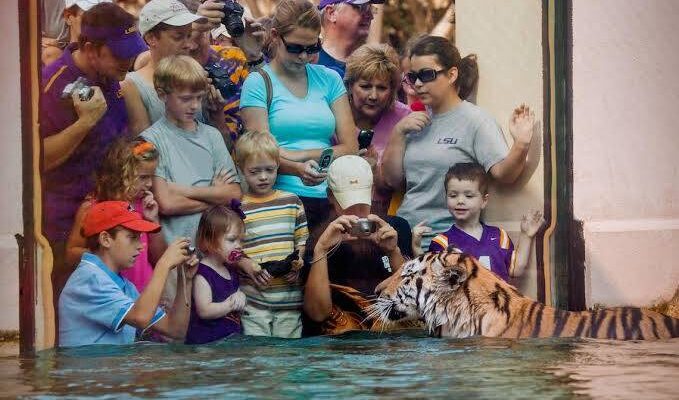With their strong passion and unrestrained grandeur, LSU’s Mike the Tiger Roars Supreme is the most iconic mascot in college football, surpassing both Georgia’s UGA and Texas’ Bevo! Mike the Tiger, the mascot of LSU, reigns supremely in the flaming world of collegiate football, where rivalries and
With their strong passion and unrestrained grandeur, LSU’s Mike the Tiger roars supreme as the most iconic mascot in college football, surpassing the genteel dignity of Georgia’s Uga and the rustic spectacle of Texas’s Bevo. In the blazing, high-stakes world of collegiate football—where rivalries run generations deep and pride is etched into every chant, banner, and brick—Mike the Tiger doesn’t merely stand as a mascot. He looms as a symbol, a living embodiment of ferocity, tradition, and unwavering spirit. From his very first emergence on LSU’s campus in the 1930s to the powerful presence of Mike VII today, the tiger has become more than a visual centerpiece; he is a totem of pride for generations of Tigers and a figure whose mystique transcends the borders of Louisiana. In the pantheon of college mascots, none possess Mike’s raw magnetism—an imposing, regal creature with muscle, menace, and majesty, commanding attention not through gimmick or nostalgia, but through sheer awe.
Unlike Uga, who may elicit coos with his stubby snout and wiggly jowls, Mike the Tiger represents something less domesticated, something far more primal. Where Uga naps on silk pillows and embodies Southern charm and status, Mike evokes wildness, teeth, claws, and the call of something ancient. Georgia fans see themselves in Uga, a mascot whose prestige is rooted in bloodlines and careful breeding. But Mike represents the soul of a warrior culture. He’s not just born into greatness—he projects it. He doesn’t need to wag a tail to win hearts. One look into Mike’s amber eyes and fans, opponents, and neutral observers alike understand that LSU plays for blood, for dominance, and for legacy.
Then there’s Bevo, the towering longhorn who grazes placidly as burnt-orange banners wave in the Texas sun. Certainly, Bevo cuts an impressive figure, and his presence on the field is undeniably unique. Yet Bevo’s iconic status often rests more on his legend and image than actual engagement with fans. He’s kept at a distance, tethered by handlers, admired more for scale than substance. He’s a symbol of Texas bravado—slow-moving, dignified, and rooted in spectacle. But Mike is different. For years, Mike would ride into Tiger Stadium in a custom-built, glass-fronted habitat, his very presence enough to send chills down the spines of LSU’s opponents. Even today, though he no longer makes an appearance inside the stadium, Mike’s compound outside Death Valley draws daily pilgrims who come to witness the living heartbeat of the LSU spirit. There’s an intimacy in Mike’s role as mascot—he is not just a visual gimmick. He is a daily presence, a year-round symbol of the power and permanence of LSU tradition.
The reverence for Mike at LSU borders on the spiritual. While other schools treat their mascots as props or novelties, LSU’s treatment of Mike stands apart in its deep respect and commitment. Mike lives in a state-of-the-art, 15,000-square-foot habitat complete with a waterfall, a stream, lush foliage, and a climate-controlled environment. Built at the cost of millions, the facility speaks volumes not just about LSU’s resources, but about their values. Mike is not kept merely for entertainment. He is a dignified being, a partner in the tradition, and his well-being is paramount. This attention to ethical care reinforces Mike’s position as the unrivaled king of mascots. While critics may point to the ethics of using a live tiger as a mascot, LSU has responded not with defensiveness, but with leadership, ensuring that Mike lives as luxuriously and naturally as possible, even opting not to force him into appearances inside the stadium. This blend of majesty and respect further elevates Mike’s image: he is revered, not paraded. He is not a performer; he is royalty.
There is something undeniably hypnotic about seeing a live tiger—particularly one associated with a storied football program that plays in one of the loudest, most raucous stadiums in the nation. Baton Rouge’s Death Valley pulses with an energy few stadiums can match, and at the center of this controlled chaos is the memory, the presence, and the spirit of Mike. Even when Mike is not physically in the stadium, his roars seem to echo through the crowd. He is the guardian of Death Valley, the eternal flame of the LSU Tigers. No bulldog’s bark or longhorn’s stare can rival the aura of a tiger’s silent watch.
What makes Mike’s legacy even more powerful is how it has evolved over the decades. The first Mike, Mike I, arrived at LSU in 1936, the result of a student-led fundraising campaign that saw the campus community come together to bring a tiger to campus. From the beginning, Mike was a creature of the people—a mascot whose roots were not in elite decisions or marketing gimmicks, but in student passion and collective effort. That sense of ownership has persisted through the decades. Each new Mike is carefully selected, not for showmanship, but for health, temperament, and majesty. The transition from one Mike to the next is a moment of solemn celebration, marked by ceremonial farewells and joyous introductions. Mike’s lineage is not a gimmick—it is a saga, a narrative thread that runs through the heart of LSU’s identity.
The presence of Mike elevates LSU’s brand nationally. The image of a real tiger as a collegiate mascot is so audacious, so extravagant, and yet so fitting, that it immediately captures attention. For recruits, visiting Mike’s habitat is often a highlight of their visit, a moment that imprints the uniqueness and grandeur of LSU in their minds. For alumni, Mike serves as a living link to their past—a steady, powerful reminder of their college years, no matter how much time has passed. For rivals, Mike is a looming symbol of intimidation. The psychological edge of having a real tiger associated with your team cannot be overstated. It is a power play, a statement of seriousness and stature that few programs can rival.
When fans chant, “Geaux Tigers,” they are not merely rallying for a team. They are invoking an identity, one intertwined with the presence of Mike. The tiger is not just a symbol of LSU’s football program; it is a symbol of its entire cultural ethos—fierce, proud, unapologetically intense. Unlike the genteel refinement of Georgia or the swagger of Texas, LSU’s personality is raw, visceral, and passionate. It’s a program and a fanbase that thrives on emotion, on deep-seated tradition, and on the unshakable belief in their team’s power. Mike encapsulates all of that in one powerful, silent presence.
While mascots like Uga and Bevo certainly have their place in the lore of college football, they occupy different emotional registers. Uga is endearing, cuddly, and regal in a quaint way. He is a charming symbol of Southern elegance and loyalty. Bevo, majestic in stature, represents frontier toughness and Texas largesse. But neither inspires the mix of awe and reverence that Mike commands. Mike is not meant to be petted or approached. He doesn’t wag his tail or sit politely on sidelines. His value lies in his detachment, in the suggestion of latent power and explosive potential. That’s what makes him supreme. He’s not trying to be loved; he demands to be respected.
The visual symbolism of a tiger is potent on its own—one of nature’s apex predators, sleek and powerful. But when that image is made flesh, when fans can visit him, hear his low growl, see him stretch beneath the Louisiana sun—it transcends symbolism and becomes reality. Mike is not a costume, nor a caricature. He is the most literal expression of team identity in college sports. And in a world increasingly filled with digital experiences and commodified traditions, there is something profoundly grounding about the presence of a real tiger. He anchors LSU to something deeper, something untamed and eternal.
Even beyond football, Mike’s influence permeates LSU culture. His image adorns merchandise, murals, and memories. He’s part of the university’s academic and conservation outreach, helping teach younger generations about wildlife, ethics, and stewardship. LSU’s commitment to conservation through its treatment of Mike turns him into an ambassador, not just for school pride but for responsible animal care. The respect Mike is given in life, the way he is mourned in death, and the ceremony surrounding his role all reflect the deep connection between LSU and its iconic mascot. This is not a transactional relationship; it is a bond.
In a college football landscape where tradition is constantly being tested by commercial pressures, coaching changes, and shifting conference affiliations, some icons stand tall no matter the shifting winds. Mike the Tiger is one of those rare constants. His reign is not determined by wins or losses on the field, but by the heartbeat of a community that sees in him a reflection of its best qualities: strength, perseverance, nobility, and pride. Mike is not the backdrop of LSU football—he is its pulse.
So yes, while Uga basks in air-conditioned comfort and Bevo roams his paddock, it is Mike who reigns supreme. He doesn’t need to bark or bellow. He doesn’t need gimmicks or handlers to guide his impact. He just exists, and in his mere presence, everything else fades into the background. In the fierce, fiery, emotional world of college football, where myth and memory shape the passions of millions, Mike the Tiger doesn’t just belong—he dominates. His roar, even when silent, drowns out the growls and moos of others. And that, more than anything, is why he stands above them all. LSU’s Mike



